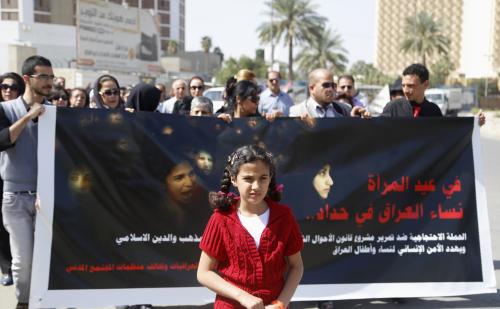The Iraq policy debate in the United States changed dramatically this past week. The call for the rapid removal of US troops from Iraq by Rep. Jack Murtha (D) of Pennsylvania, as well as the debate in the Senate, show that it is no longer obligatory for hawks to insist on staying the course whatever the costs. Mr. Murtha, a strong pro-defense Democrat and decorated Vietnam vet, said it best when he suggested that he was just catching up to the American people with his call for redeployment. Polling numbers on support for the war in Iraq bear him out.
Iraq presents a policy quandary of the first order. The US presence in that country is both part of the problem and a necessary part of any solution. US troops must be there to provide security until Iraqis can do so for themselves. Yet their large presence also galvanizes the resistance and motivates the jihadists. The US needs a viable exit strategy—not only to save American dollars and lives, but to prevail in the mission to leave behind a stable, functioning Iraq.
A complete US withdrawal from Iraq, however, could lead unintentionally to defeat. Iraqi security forces as well as the Iraqi government are nowhere near being able to keep a cohesive nation together on their own. A time certain for withdrawal, not tied to the situation on the ground, could embolden the resistance and weaken the resolve of Iraq’s patriots who are trying—with limited but still real success—to build a new nation.
But if calls for a firm withdrawal date go too far in one direction, the administration goes too far in the other. Its steadfast commitment to purpose fails to acknowledge how unpopular our presence is within Iraq and how much it acts as a gravitational force for the global Al Qaeda movement. American polling agencies in Iraq basically stopped asking Iraqis what they thought of the US and its troops when our unpopularity approached 90 percent in Iraq in the spring of 2004. There is little reason to think the situation has improved. And clearly, for jihadists, the presence of American troops in Iraq makes it the epicenter of their worldwide struggle today. That is of course one reason the US must not fail. But it is also a reason why it must minimize its presence at the earliest opportunity.
To try to avoid the pitfalls of either staying the course or withdrawing completely—and to take the best ideas of each—we propose the following exit strategy:
- A clear statement from Washington that it intends to downsize troop presence dramatically once Iraqis are in a position to protect themselves. Specifically, at least three-quarters of US troops should come home from Iraq as soon as a number of conditions are met, probably over the next 18 months.
- A pledge to reduce the foreign military presence by one soldier for every two Iraqi soldiers within units that become certified as meeting the first—or second—highest level of combat readiness, as defined by joint US-Iraqi military assessments.
- A further stipulation that the foreign drawdown could accelerate if Iraq makes faster progress in rehabilitating its infrastructure and building its government ministries.
- More detailed monthly reports from the administration, in both unclassified and classified form, on progress in security and economic areas.
- An effort to elicit much greater European and UN help in the effort to improve Iraq’s government ministries in particular.
- Establishment of an international contact group, such as the one in the Balkans, to help oversee the rebuilding of Iraq. This would help make the effort to rebuild Iraq more international, which would help reverse the flagging support of the American people for the Iraq mission.
- A firm reaffirmation that the US will leave Iraq entirely at any point the Iraqi government requests it.
- An additional declaration that the US has no plans for longer-term military bases in Iraq and any discussion of that subject would have to await the next American administration, would have to be initiated by Iraq, and would have to be discussed at the UN Security Council.
After the drawdown period, outside forces may need to maintain 30,000 to 40,000 troops in Iraq, ideally under NATO leadership—roughly the number needed to continue training Iraqi forces, to help protect the Green Zone, and to maintain several mobile combat brigades in a number of regions to back up Iraqi Security Forces. And it might be necessary to keep that number for a period of time. But such numbers would become a ceiling, not a floor, in future policy discussions.
This plan would be a strategically sound exit strategy. It would in effect honor and respect the better parts of the arguments made by both the administration and its critics. It also has the added benefit of more clearly empowering the Iraqis to determine when and under what circumstances foreign troops will withdraw. When the conditions are met, the troops will go. Bringing the Iraqi government into the process of deciding their own fate is essential to the success of any plan.
The Brookings Institution is committed to quality, independence, and impact.
We are supported by a diverse array of funders. In line with our values and policies, each Brookings publication represents the sole views of its author(s).



Commentary
Op-edPlan a Moderate Iraq Exit Strategy
November 22, 2005